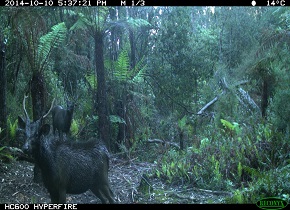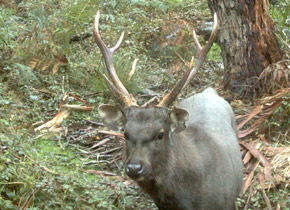Managing mammals
Management of introduced Sambar Deer in Victoria

Chris Davies is undertaking research on Sambar Deer in Victoria. The extent of the spread of this introduced species in Australia is not fully understood, however there is evidence that they are negatively impacting some native ecosystems. Using GPS tracking collars and genetic methods, Chris is gaining insight into the range, movement patterns and population structure of Victorian Sambar Deer. Little research has been performed on this deer species and Chris’ work will provide information to better manage this population.
The Australian Sambar Deer population has been steadily growing since their introduction in the 1860’s from Asia. Sambar Deer are now known to inhabit almost every forested area in Victoria, however little research has been undertaken regarding their behaviour and their impact on native flora and fauna. There is anecdotal evidence to suggest Sambar populations cause damage to native vegetation and natural watercourses, which can cause severe disruption to sensitive communities such as those in alpine forests.
 Chris is studying the distribution of Sambar Deer and their behaviour and movement using GPS tracking collars and motion-activated cameras, collecting previously unknown information about these animals. The data he collects will allow him to gain a better understanding of just how widespread Sambar Deer are, and how their behaviour is impacting sensitive ecosystems. Chris is also performing a genetic study using DNA from faeces (scats) and tissue samples obtained from deer shot by hunters.
Chris is studying the distribution of Sambar Deer and their behaviour and movement using GPS tracking collars and motion-activated cameras, collecting previously unknown information about these animals. The data he collects will allow him to gain a better understanding of just how widespread Sambar Deer are, and how their behaviour is impacting sensitive ecosystems. Chris is also performing a genetic study using DNA from faeces (scats) and tissue samples obtained from deer shot by hunters.
Upon completion, this research is expected to yield insight into the structure of and relatedness between isolated pockets of the Victorian Sambar Deer population. This information will help develop effective Sambar Deer management strategies for the future.
Acknowledgements
Chris’ work on this project is supported by the Holsworth Research Endowment, Bill Borthwick Student Scholarship, Australian Deer Association, the Department of Environment, Land, Water and Planning and the School of Applied and Biomedical Sciences (FedUni) and his supervisors are Dr. Fiona Hogan, Associate Professor Wendy Wright & Dr. Simon Cook.
Bat roost Research in central New South Wales

Dr. Simon Cook works in collaboration with a New South Wales mine to preserve bat species in the Broken Hill area. Many bat species rely on trees with hollows for daytime roosting, and Dr. Cook has the unique opportunity of studying these hollows as land is cleared for mining. Before land is cleared, he identifies and marks hollow-bearing trees. After clearing, armed with a chainsaw and crowbar, he opens and gains access to each hollow, and removes any resident bats for relocation.
Tree hollows are extremely important to many Australian animals, including a large number of bat species. As Australia has no native woodpeckers, tree hollows are only created by time, termites or fire, so the number of these trees is limited across the continent and they are very slow to develop. In the mining region of New South Wales, areas of land up to 100 hectares in size are cleared for mining activity. The areas are revegetated once activity has ceased, however this does not return the hollow-bearing trees to the area, which take many years to form. Bats in particular are affected by this activity, as the semi-desert environment of western New South Wales is extremely hostile to these nocturnal animals during the daytime.
 Bats are thought to be highly selective when choosing roosting sites, but very little research has been undertaken into hollow use. Tree hollows are often formed many metres above the ground, and as a result are difficult to access and can rarely be studied in depth. Where land is cleared for mining, these trees are knocked to the ground, which gives Simon rare access to hollows. This allows for the safe relocation of the many bats that occupying hollows, and also provides insight into the roosting preferences and hollow selectivity of different bat species.
Bats are thought to be highly selective when choosing roosting sites, but very little research has been undertaken into hollow use. Tree hollows are often formed many metres above the ground, and as a result are difficult to access and can rarely be studied in depth. Where land is cleared for mining, these trees are knocked to the ground, which gives Simon rare access to hollows. This allows for the safe relocation of the many bats that occupying hollows, and also provides insight into the roosting preferences and hollow selectivity of different bat species.
Bat-boxes (for roosting) are being deployed in revegetated areas, and it is hoped that knowledge of bat roosting preferences can improve box design and conservation outcomes.
Further information
For more information on the above, feel free to contact us via our Wildlife Conservation Research contact page.